Assessment of Internal Damage in Sandwich Structures by Post-Processing of Mode Shapes Using Curvelet Transform
Abstract
:1. Introduction
2. Tested Structures and Damage Identification Algorithm
2.1. Pre-Damaged Sandwich Structures
2.2. Acquisition of Mode Shapes
2.3. Acquisition of Mode Shapes
2.4. Damage Identification Algorithm
- (1)
- Calculating 2D Fourier transform (FT) to transform space domain variables (mode shapes, in our case) in the form of the frequency domain variables .
- (2)
- Calculating the product of the determined variables with a frequency window: .
- (3)
- Wrapping the above product around the origin: .
- (4)
- Calculating inverse 2D FT for to obtain .
- H0—the element (s,p) of a structure is healthy;
- H1—the element (s,p) of a structure is damaged.
3. Results and Discussion
3.1. Analysis of Detectability of Various Damage Types
3.2. Quantification of Damage Shape
4. Conclusions
Author Contributions
Funding
Data Availability Statement
Acknowledgments
Conflicts of Interest
References
- Pieczonka, L.; Ukowski, P.; Klepka, A.; Staszewski, W.J.; Uhl, T.; Aymerich, F. Impact damage detection in light composite sandwich panels using piezo-based nonlinear vibro-acoustic modulations. Smart Mater. Struct. 2014, 23, 105021. [Google Scholar] [CrossRef]
- Manalo, A.; Aravinthan, T.; Fam, A.; Benmokrane, B. State-of-the-art review on FRP sandwich systems for lightweight civil infrastructure. J. Compos. Constr. 2017, 21, 04016068. [Google Scholar] [CrossRef] [Green Version]
- Birman, V.; Kardomateas, G.A. Review of current trends in research and applications of sandwich structures. Compos. Part B 2018, 142, 221–240. [Google Scholar] [CrossRef]
- Castanie, B.; Bouvet, C.; Ginot, M. Review of composite sandwich structure in aeronautic applications. Compos. Part C 2020, 1, 100004. [Google Scholar]
- Yang, J.-S.; Liu, Z.-D.; Schmidt, R.; Schröder, K.-U.; Ma, L.; Wu, L.-Z. Vibration-based damage diagnosis of composite sandwich panels with bi-directional corrugated lattice cores. Compos. Part A 2020, 131, 105781. [Google Scholar] [CrossRef]
- Bulut, M. Low-velocity impact tests on basalt fiber/polypropylene core honeycomb sandwich composites. Mech. Compos. Mater. 2020, 56, 121–130. [Google Scholar] [CrossRef]
- Růžek, R.; Lohonka, R.; Jironč, J. Ultrasonic C-Scan and shearography NDI techniques evaluation of impact defects identification. NDT&E Int. 2006, 39, 132–142. [Google Scholar]
- Revel, G.M.; Pandarese, G.; Cavuto, A. Advanced ultrasonic non-destructive testing for damage detection on thick and curved composite elements for constructions. J. Sandw. Struct. Mater. 2012, 15, 5–24. [Google Scholar] [CrossRef]
- Bělský, P.; Kadlec, M. Capability of non-destructive techniques in evaluating damage to composite sandwich structures. Int. J. Struct. Integr. 2019, 10, 356–370. [Google Scholar] [CrossRef]
- Gillespie, D.I.; Hamilton, A.W.; Atkinson, R.C.; Bellekens, X.; Michie, C.; Adronovic, I.; Tachtatzis, C. Defect detection in aerospace sandwich composite panels using conductive thermography and contact sensors. Sensors 2020, 20, 6689. [Google Scholar] [CrossRef] [PubMed]
- Xie, H.; Fang, H.; Li, X.; Wan, L.; Wu, P.; Yu, Y. Low-velocity impact damage detection and characterization in composite sandwich panels using infrared thermography. Compos. Struct. 2021, 269, 114008. [Google Scholar] [CrossRef]
- He, Y.; Tian, G.Y.; Pan, M.; Chen, D. Non-destructive testing of low-energy impact in CFRP laminates and interior defects in honeycomb sandwich using scanning pulsed eddy current. Compos. Part B 2014, 59, 196–203. [Google Scholar] [CrossRef] [Green Version]
- Mustapha, S.; Ye, L.; Dong, X.; Alamdari, M.M. Evaluation of barely visible indentation damage (BVID) in CF/EP sandwich composites using guided wave signals. Mech. Syst. Signal Process. 2016, 76–77, 497–517. [Google Scholar] [CrossRef]
- Sikdar, S.; Banerjee, S. Guided wave based nondestructive analysis of localized inhomogeneity effects in an advanced sandwich composite structure. Compos. Part B 2019, 176, 107195. [Google Scholar] [CrossRef]
- Zhu, J.; Wang, Y.; Qing, X. Modified electromechanical impedance-based disbond monitoring for honeycomb sandwich composite structure. Compos. Struct. 2019, 217, 175–185. [Google Scholar] [CrossRef]
- Mieloszyk, M.; Jurek, M.; Majewska, K.; Ostachowicz, W. Terahertz time domain spectroscopy and imaging application for analysis of sandwich panel with embedded fibre Bragg grating sensors and piezoelectric transducers. Opt. Las. Eng. 2020, 134, 106226. [Google Scholar] [CrossRef]
- Janeliukstis, R.; Mironovs, D. Smart composite structures with embedded sensors for load and damage monitoring—A review. Mech. Compos. Mater. 2021, 57, 131–152. [Google Scholar] [CrossRef]
- Nsengiyumva, W.; Zhong, S.; Lin, J.; Zhang, Q.; Zhong, J.; Huang, Y. Advances, limitations and prospects of nondestructive testing and evaluation of thick composites and sandwich structures: A state-of-the-art review. Compos. Struct. 2020, 256, 112951. [Google Scholar] [CrossRef]
- Kumar, M.; Shenoi, R.A.; Cox, S.J. Experimental validation of modal strain energies based damage identification method for a composite sandwich beam. Compos. Sci. Technol. 2009, 69, 1635–1643. [Google Scholar] [CrossRef]
- Li, B.; Li, Z.; Zhou, J.; Ye, L.; Li, E. Damage localization in composite lattice truss core sandwich structures based on vibration characteristics. Compos. Struct. 2015, 126, 34–51. [Google Scholar] [CrossRef]
- Lu, L.; Song, H.; Huang, C. Experimental investigation of unbound nodes identification for metallic sandwich panels with truss core. Compos. Struct. 2017, 163, 248–256. [Google Scholar] [CrossRef]
- Zhou, Y.; Xu, Y.; Liu, H.; Guo, Y.; Yi, X.; Jia, Y. Debonding identification of Nomex honeycomb sandwich structures based on the increased vibration amplitude of debonded skin. Compos. Part B 2020, 200, 108233. [Google Scholar] [CrossRef]
- Lestari, W.; Qiao, P. Damage detection of fiber-reinforced polymer honeycomb sandwich beams. Compos. Struct. 2005, 67, 365–373. [Google Scholar] [CrossRef]
- Rucevskis, S.; Wesolowski, M.; Chate, A. Damage detection in laminated composite beam by using vibration data. J. Vibroeng. 2009, 11, 363–373. [Google Scholar]
- Seguel, F.; Meruane, V. Damage assessment in a sandwich panel based on full-field vibration measurements. J. Sound Vib. 2018, 417, 1–18. [Google Scholar] [CrossRef]
- Yang, J.-S.; Ma, L.; Chaves-Vargas, M.; Huang, T.-X.; Schröder, K.-U.; Schmidt, R.; Wu, L.-Z. Influence of manufacturing defects on modal properties of composite pyramidal truss-like core sandwich cylindrical panels. Compos. Sci. Technol. 2017, 147, 89–99. [Google Scholar] [CrossRef]
- Lu, L.; Song, H.; Huang, C. Effects of random damages on dynamic behavior of metallic sandwich panel with truss core. Compos. Part B 2017, 116, 278–290. [Google Scholar] [CrossRef] [Green Version]
- Katunin, A. Vibration-based spatial damage identification in honeycomb-core sandwich composite structures using wavelet analysis. Compos. Struct. 2014, 118, 385–391. [Google Scholar] [CrossRef]
- Zhou, J.; Li, Z. Damage detection based on vibration for composite sandwich panels with truss core. Compos. Struct. 2019, 229, 111376. [Google Scholar] [CrossRef]
- Katunin, A.; Przystałka, P. Automated wavelet-based damage identification in sandwich structures using modal curvatures. J. Vibroeng. 2015, 17, 2977–2986. [Google Scholar]
- Liu, Z.; Ardabilian, M.; Zine, A.; Ichchou, M. Crack damage identification of a thick composite sandwich structure based on Gaussian Processes classification. Compos. Struct. 2021, 225, 112825. [Google Scholar] [CrossRef]
- Katunin, A. Damage identification in composite plates using two-dimensional B-spline wavelets. Mech. Syst. Signal Process. 2011, 25, 3153–3167. [Google Scholar] [CrossRef]
- Janeliukstis, R.; Rucevskis, S.; Wesolowski, M.; Chate, A. Experimental structural damage localization in beam structure using spatial continuous wavelet transform and mode shape curvature methods. Measurement 2017, 102, 253–270. [Google Scholar] [CrossRef]
- Candès, E.J.; Donoho, D.L. Curvelets: A surprisingly effective nonadaptive representation of objects with edges. In Curve and Surface Fitting; Cohen, A., Rabut, C., Schumaker, L.L., Eds.; Vanderbilt University Press: Nashville, TN, USA, 2000. [Google Scholar]
- Wang, L.; Yang, Z.; Waters, T.P. Structural damage detection using cross correlation functions of vibration response. J. Sound Vib. 2010, 329, 5070–5086. [Google Scholar] [CrossRef]
- Katunin, A. Damage identification and quantification in beams using Wigner-Ville distribution. Sensors 2020, 20, 6638. [Google Scholar] [CrossRef]
- Katunin, A. Identification of structural damage using S-transform from 1D and 2D mode shapes. Measurement 2021, 173, 108656. [Google Scholar] [CrossRef]
- Welland, G.V. Beyond Wavelets. In Studies in Computational Mathematics 10; Chui, C.K., Monk, P., Wuytack, L., Eds.; Academic Press: San Diego, CA, USA, 2003. [Google Scholar]
- Mumtaz, R.; Mumtaz, M.; Mansoor, A.B.; Masood, H. Computer aided visual inspection of aircraft structures. Int. J. Image Process. 2012, 6, 38–53. [Google Scholar]
- Xu, K.; Liu, S.; Ai, Y. Application of Shearlet transform to classification of surface defects for metals. Image Vis. Comput. 2015, 35, 23–30. [Google Scholar] [CrossRef]
- Umamaheswara Raju, R.S.; Ramachandra Raju, V.; Ramesh, R. Curvelet transform for estimation of machining performance. Optik 2017, 131, 615–625. [Google Scholar] [CrossRef]
- Tzanis, A. A versatile tuneable curvelet-like directional filter with application to fracture detection in two-dimensional GPR data. Signal Proc. 2017, 132, 243–260. [Google Scholar] [CrossRef]
- Anandan, P.; Sabeenian, R.S. Fabric defect detection using Discrete Curvelet Transform. Proc. Comput. Sci. 2018, 133, 1056–1065. [Google Scholar]
- Bagheri, A.; Ghodrati Amiri, G.; Seyed Razzaghi, S.A. Vibration-based damage identification of plate structures via curvelet transform. J. Sound Vib. 2009, 327, 593–603. [Google Scholar] [CrossRef]
- Nicknam, A.; Hosseini, M.H.; Bageri, A. Damage detection and denoising in two-dimensional structures using curvelet transform by wrapping method. Arch. Appl. Mech. 2011, 81, 1915–1924. [Google Scholar] [CrossRef]
- De Marchi, L.; Baravelli, E.; Ruzzene, M.; Speciale, N.; Masetti, G. Guided wave expansion in warped curvelet frames. IEEE Trans. Ultrason. Ferroelectr. 2012, 59, 949–957. [Google Scholar] [CrossRef] [PubMed]
- Vafaie, S.; Salajegheh, E. Comparisons of wavelets and contourlets for vibration-based damage identification in the plate structures. Adv. Struct. Eng. 2019, 22, 1672–1684. [Google Scholar] [CrossRef]
- Ansari, R.A.; Budhhiraju, K.M. A comparative evaluation of denoising of remotely sensed images using wavelet, curvelet and contourlet transforms. J. Ind. Soc. Remote Sens. 2016, 44, 843–853. [Google Scholar] [CrossRef]
- Katunin, A.; John, M.; Joszko, K.; Kajzer, A. Characterization of quasi-static behavior of honeycomb core sandwich structures. Model Eng. 2014, 22, 78–84. [Google Scholar]
- Candès, E.; Demanet, L.; Donoho, D.; Ying, L. Fast discrete curvelet transforms. Multiscale Model. Simul. 2006, 5, 861–899. [Google Scholar] [CrossRef]
- Gao, R.X.; Yan, R. Beyond wavelets. In Wavelets. Theory and Applications for Manufacturing; Gao, R.X., Yan, R., Eds.; Springer: Boston, MA, USA, 2011. [Google Scholar]
- Donoho, D.L.; Duncan, M.R. Digital curvelet transform: Strategy, implementation, and experiments. Proc. SPIE 2000, 4056, 12–30. [Google Scholar] [CrossRef]
- Bayissa, W.L.; Haritosa, N.; Thelandersson, S. Vibration-based structural damage identification using wavelet transform. Mech. Syst. Signal Process. 2008, 22, 1194–1215. [Google Scholar] [CrossRef]
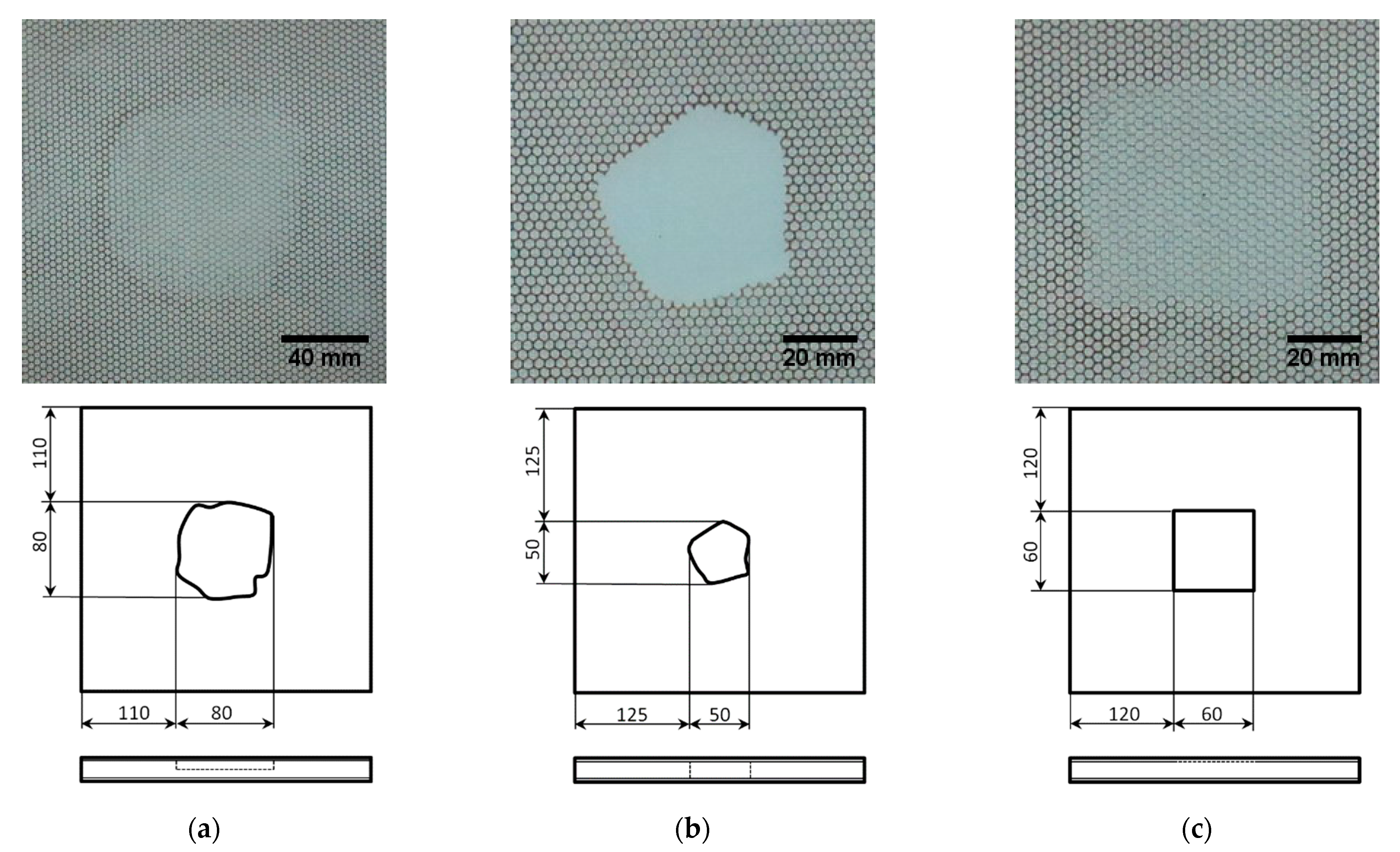
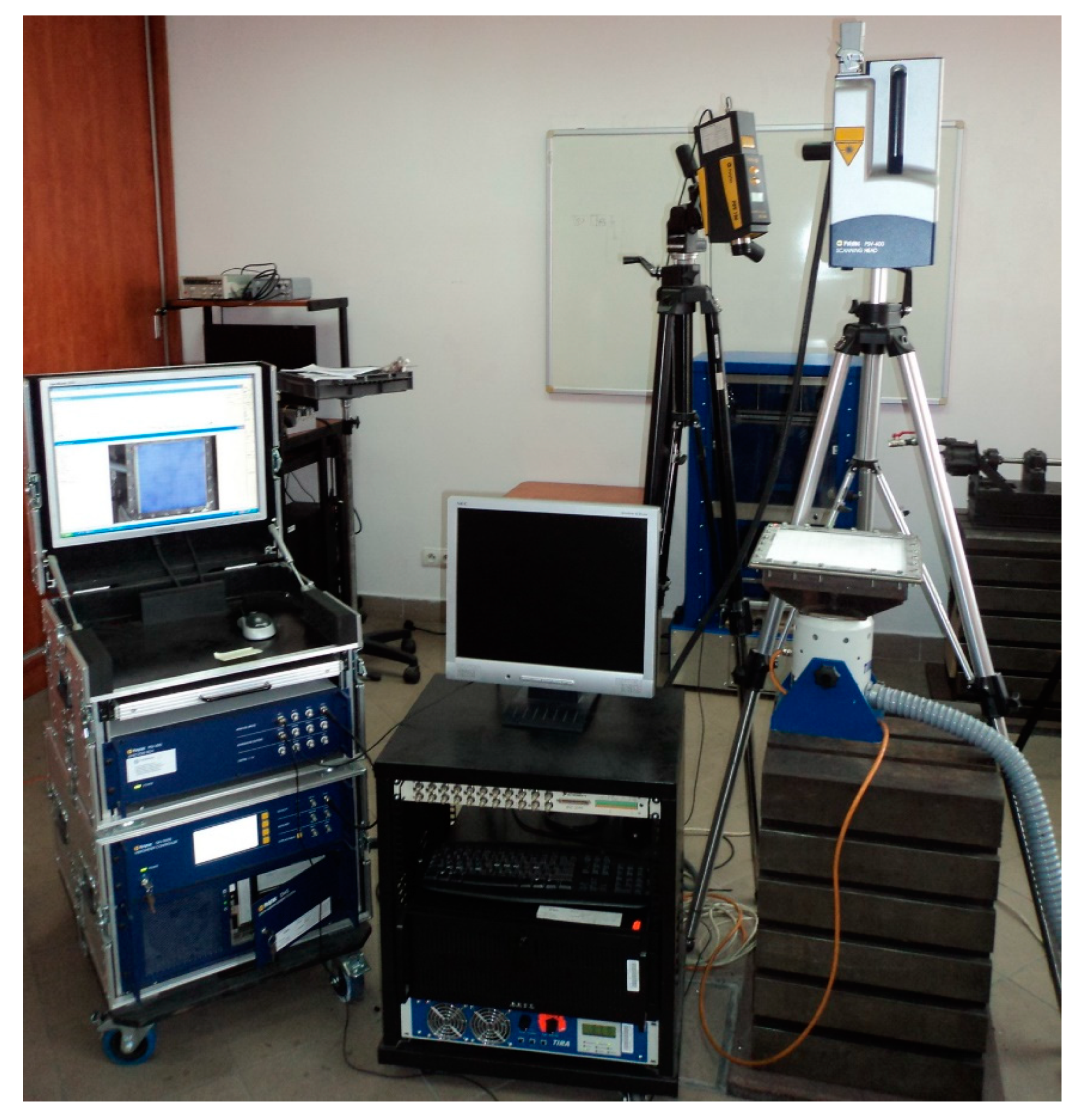
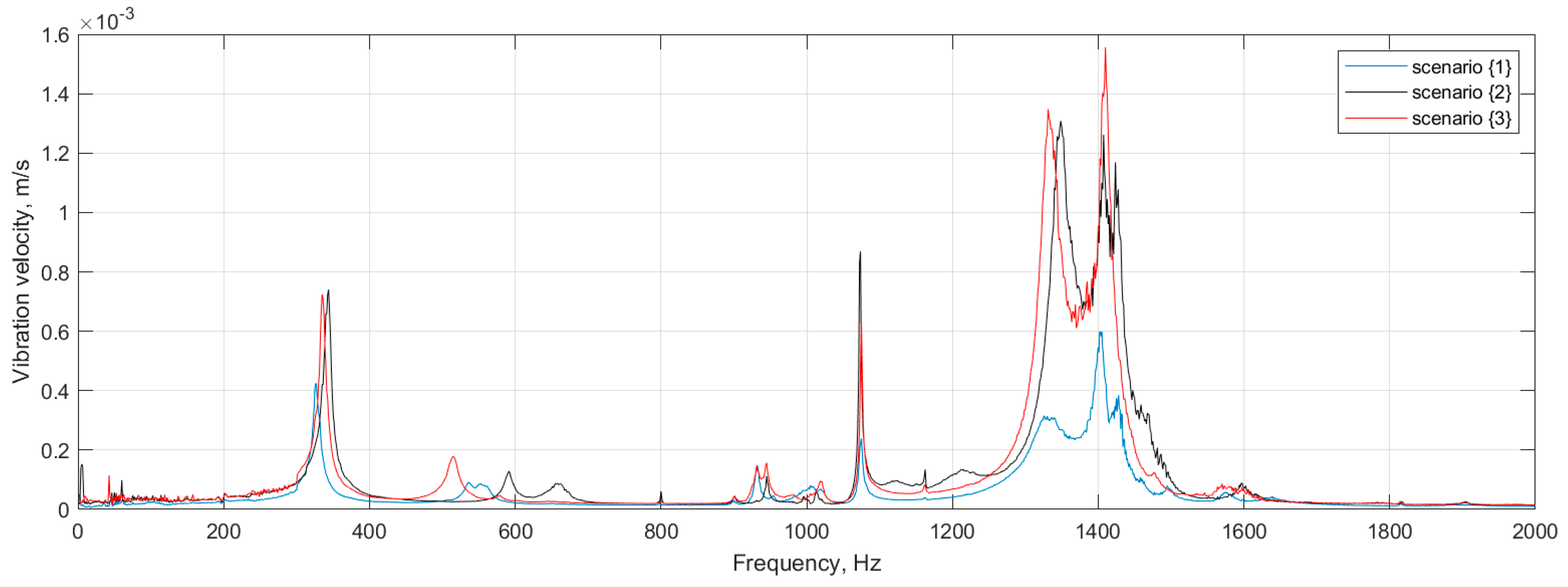
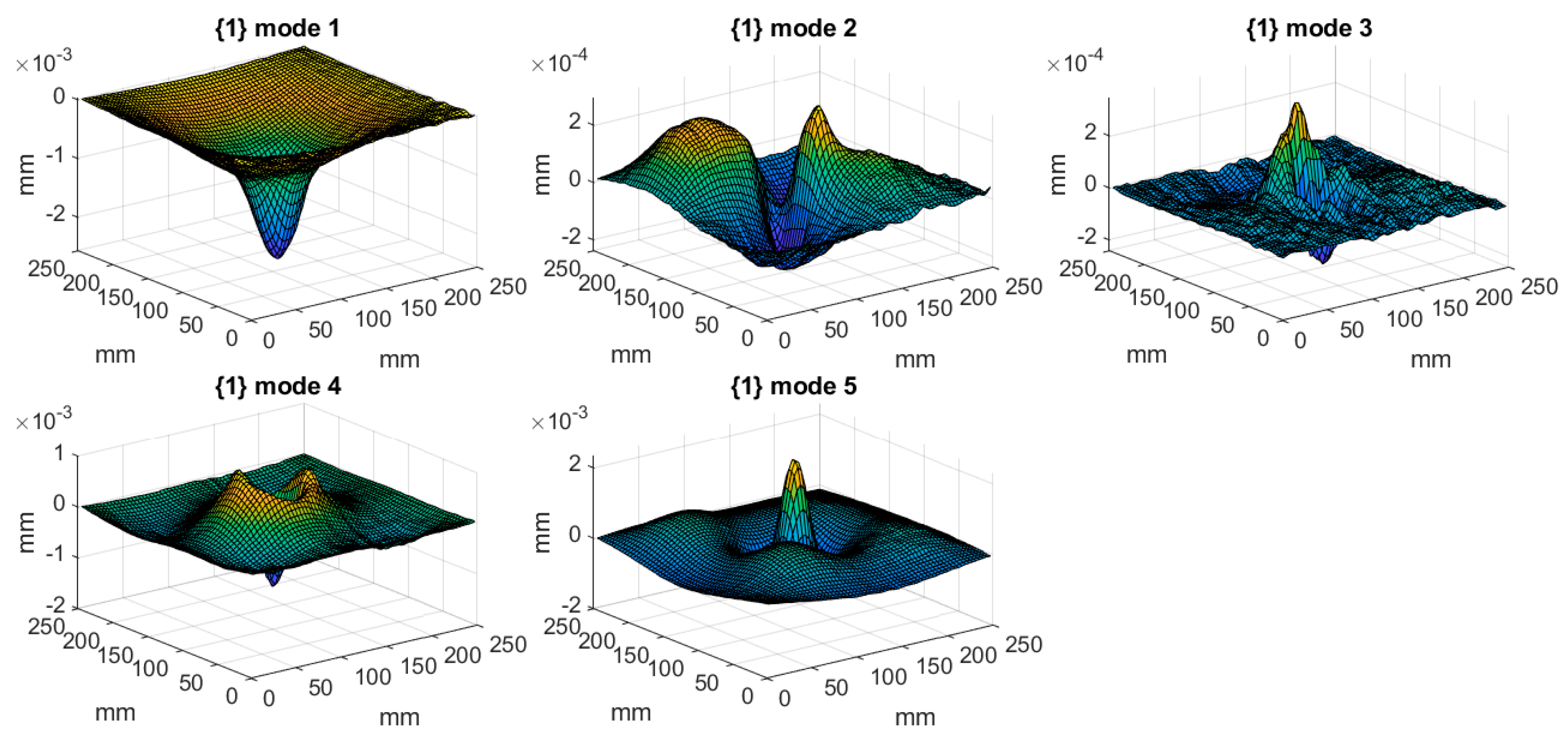

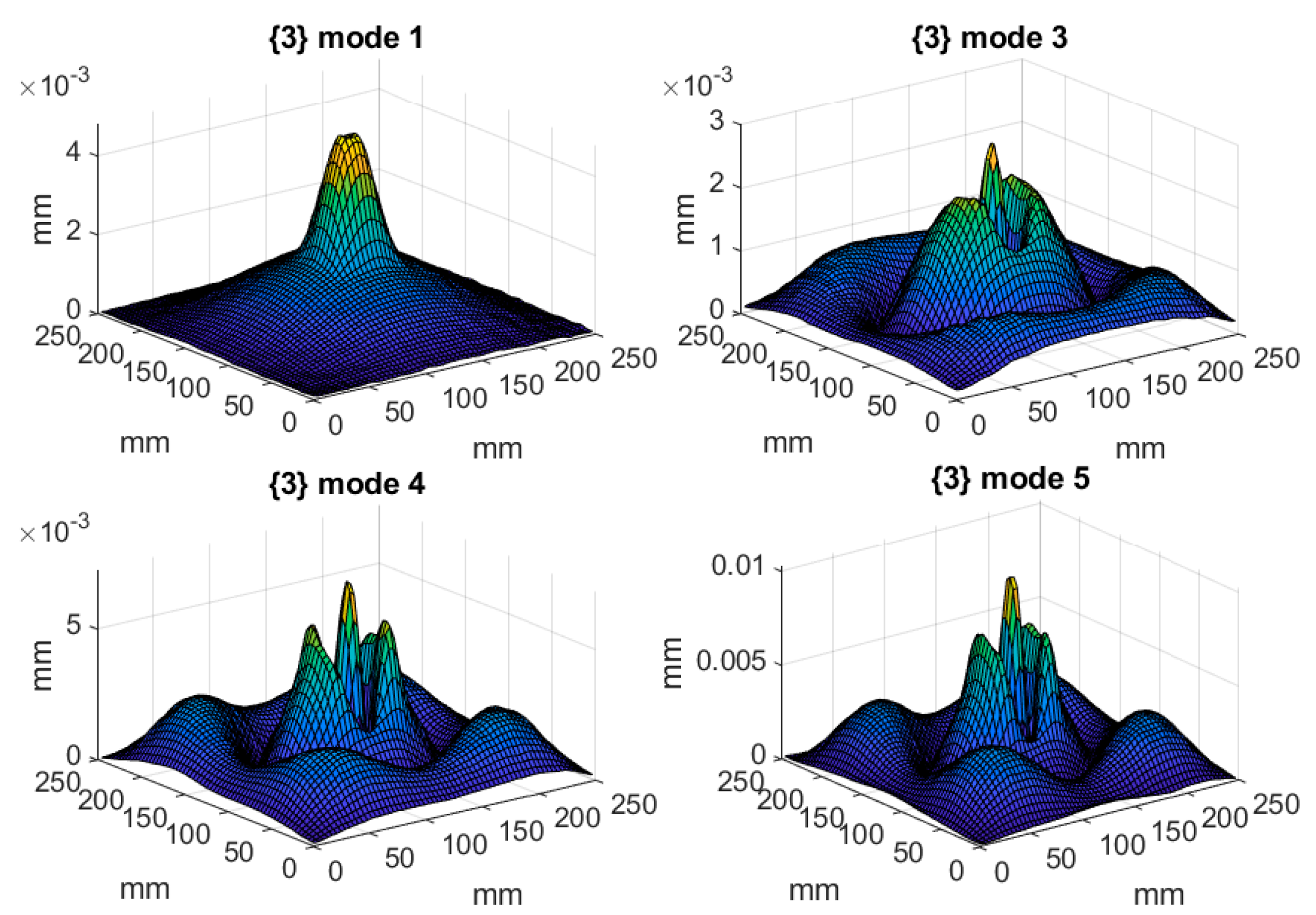





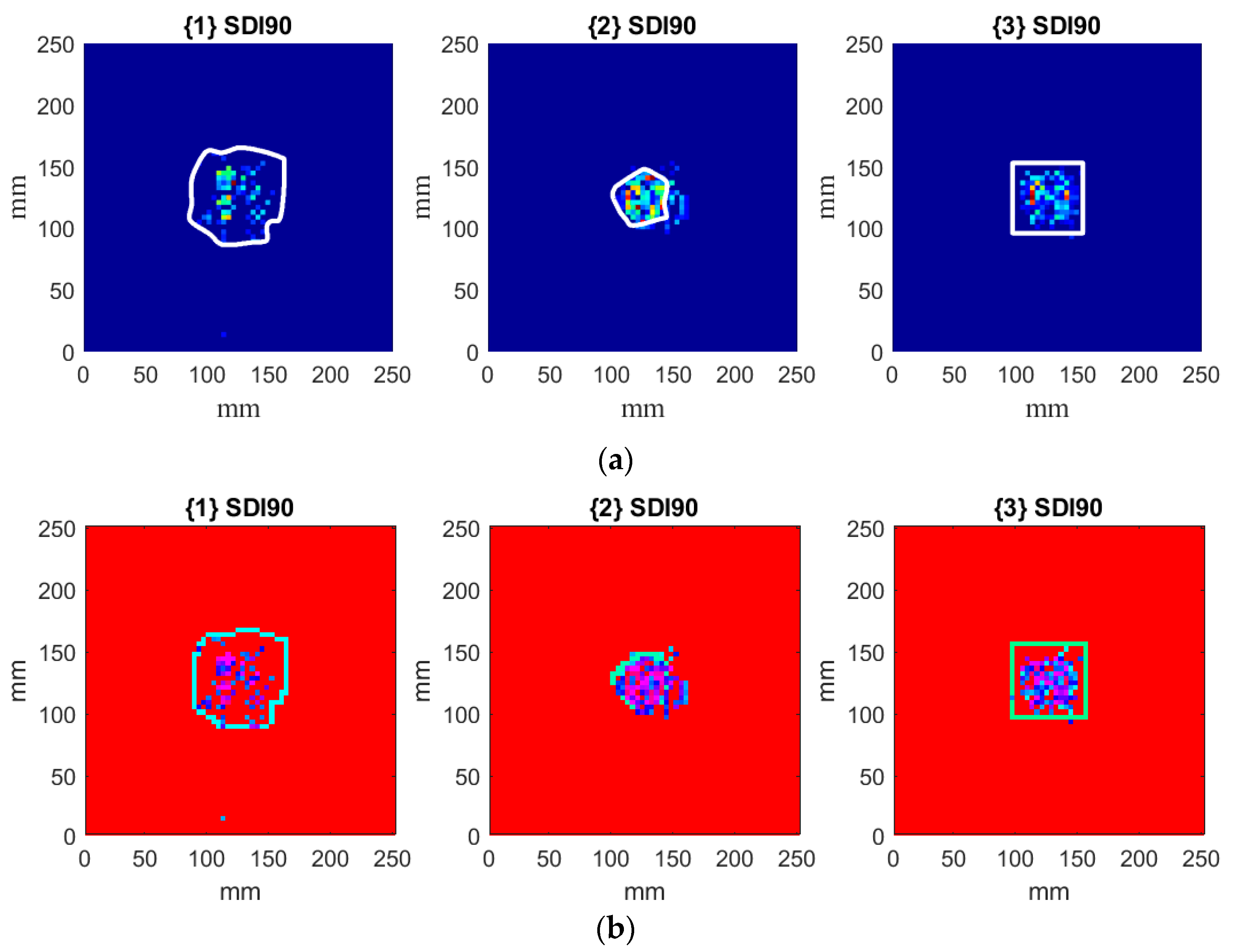

| Scenario | Type of Damage | Mode 1, Hz | Mode 2, Hz | Mode 3, Hz | Mode 4, Hz | Mode 5, Hz |
|---|---|---|---|---|---|---|
| {1} | Partial local lack of the core | 326 | 932 | 1075 | 1326 | 1405 |
| {2} | Full local lack of the core | 350 | 1073.75 | 1355 | 1427.5 | |
| {3} | Debonding between the core and the upper facing | 335 | 1075 | 1331.25 | 1410 |
Publisher’s Note: MDPI stays neutral with regard to jurisdictional claims in published maps and institutional affiliations. |
© 2021 by the authors. Licensee MDPI, Basel, Switzerland. This article is an open access article distributed under the terms and conditions of the Creative Commons Attribution (CC BY) license (https://creativecommons.org/licenses/by/4.0/).
Share and Cite
Katunin, A.; Ručevskis, S. Assessment of Internal Damage in Sandwich Structures by Post-Processing of Mode Shapes Using Curvelet Transform. Materials 2021, 14, 4517. https://doi.org/10.3390/ma14164517
Katunin A, Ručevskis S. Assessment of Internal Damage in Sandwich Structures by Post-Processing of Mode Shapes Using Curvelet Transform. Materials. 2021; 14(16):4517. https://doi.org/10.3390/ma14164517
Chicago/Turabian StyleKatunin, Andrzej, and Sandris Ručevskis. 2021. "Assessment of Internal Damage in Sandwich Structures by Post-Processing of Mode Shapes Using Curvelet Transform" Materials 14, no. 16: 4517. https://doi.org/10.3390/ma14164517
APA StyleKatunin, A., & Ručevskis, S. (2021). Assessment of Internal Damage in Sandwich Structures by Post-Processing of Mode Shapes Using Curvelet Transform. Materials, 14(16), 4517. https://doi.org/10.3390/ma14164517







